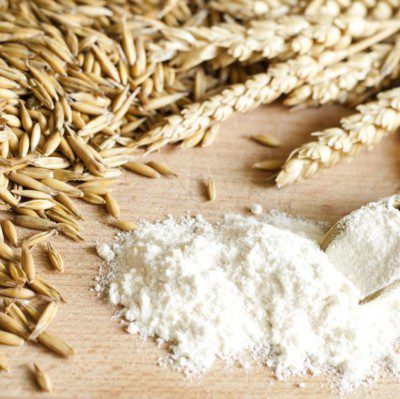Particle size correlates directly with other quality indicators of cereal flours. It helps milling and baking industry scientists and technicians to assess:
- Flour’s purity (e.g., content of bran and minerals)
- Rate and extent of water absorption (water binding capacity) of wheat flours during mixing/kneading
- Mechanical damage of starch during milling process
Relevance
Particle size of a given wheat flour is an important physical parameter for bakeries. The following are a few example of the role of its in the baking industry:
1. Particle size’s role in hydration capacity (water absorption) of flours
Hydration rate and extent are greatly dependent on the granularity of the flour used. The finer (smaller) the particle size of a flour, the greater its rate and extent of water absorption. In contrast, excessively coarse flours produce low-quality breads, since dough hydration is limited and takes longer to complete.4
Finer flours provide a homogeneous, complete, and almost instantaneous hydration of the protein macromolecules vital for dough formation and development. As a rule of thumb, the coarser the flour particles, the longer the mixing time will be, thereby increasing power consumption of spirals/planetary mixers.
2. Particle size’s role in cake-making
High-ratio flours used in cake-making are an excellent example of how particle size affects the overall texture of a product.
A successful cake-making process depends on the surface activity of the ingredients used, and so increasing the surface area of the available starch becomes important in aiding stability of the batter. For this application, it is desired that the particle size of wheat flour to be less than 90 μm.5
3. Particle size as an index for the classification of milled wheat products
The particle size index (PSI) is a widely used measure of wheat hardness (i.e., the physical resistance of wheat kernels to a crushing or shearing force as they are milled into smaller particles or flour).
AACC Method 55-30 (Particle Size Index for Wheat Hardness) involves grinding/milling of wheat, then sifting the ground material over a US Standard Mesh No. 75 in a laboratory sieve shaker or Rotap.
The proportion of particulate material that passes through the sieve, i.e., “throughs” expressed as a percentage, is the PSI; it increases with decreasing wheat hardness. For example, soft wheat varieties, which have the softest kernel texture, yield PSI values in the range of 73–77, while durum wheat varieties, which are very hard, give PSI values of 35–41 (milling of durum wheat requires a high consumption of energy).6
4. Particle size and its relation to damaged starch
The detrimental effects of milling on the overall quality of a flour are widely known in the baking and pasta-making industries. When wheat kernels are subjected to intense crushing and shearing forces during roller milling, they break apart (fractionate), becoming particulate material or stocks of different particle-size distribution. The abrasion created by the fluted/corrugated roller mills is so intense that the structure of the wheat endosperm is mechanically damaged, especially the starch granule that accounts for almost the entire composition of the flour.
The structure of the starch granules is sliced or broken, causing them to become more susceptible to enzymatic attack by amylases. Damaged starch has also more water absorption capacity, since the glucose chains are opened and exposed to bind water readily.
Since milling naturally causes mechanical damage to starch in the flour, this can only be controlled and minimized at the mill. As a rule of thumb, the more damaged starch in flour, the less suitable it is for baking applications.
Assessment of particle size
Particle size can be measured using sieves with a range of mesh sizes (5600–25 µm in mesh aperture/opening). Flour is submitted to a standardized and controlled sieving test. The flour passes through a range of flour sieves. Data are reported as the weight of material remaining on a specified sieve or sieves after sieving for a standard time, expressed as a percentage of the original weight of the sample (AACC Method 66-20.01).7
Approved method regarding particle size
- AACC International Method 66-20.01 – Determination of Granularity of Semolina and Farina by Sieving Method
- AACC International Method 55-60.01 – Guideline for Determination of Particle Size Distribution
References
- Saravacos, G.D., and Z.B. Maroulis. “Mechanical Processing Operations.” Food Process Engineering Operations, CRC Press, Taylor & Francis Group, LLC, 2011, p. 161.
- Finnie, S., and W.A. Atwell. “Wheat and Flour Testing.” Wheat Flour, 2nd ed., AACC International, Inc., 2016, p. 63.
- Codex Alimentarius. Codex Standard 152–1985 “Wheat Flour.”
- Pagani, M.A. “Wheat Milling and Flour Quality Evaluation.” Bakery Products Science and Technology, 2nd ed., John Wiley & Sons, Ltd., 2014, pp. 19–23.
- Cauvain, S.P. “Raw Materials.” Baking Problems Solved, 2nd ed., Elsevier Ltd., 2017, p. 67.
- Carson, G.R. “Criteria of Wheat and Flour Quality.” Wheat Chemistry and Technology, 4th ed., AACC International, Inc., 2009, pp. 97–98.
- Posner, E.S. “The Flour Mill Laboratory.” Wheat Flour Milling, 2nd printing, AACC International, Inc., 2011, pp. 86–87.

